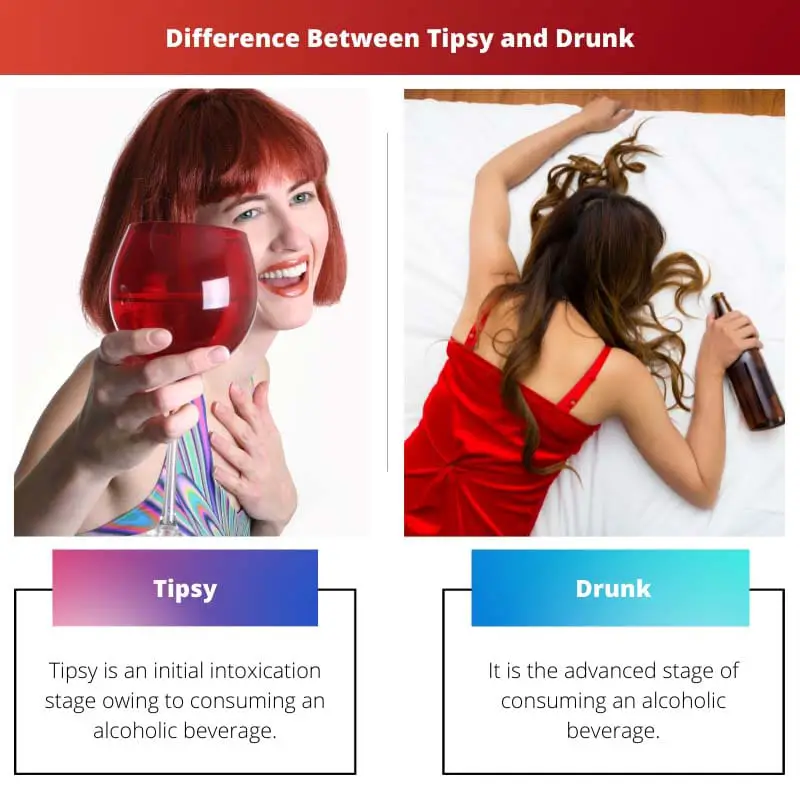Consuming Alcohol is one of the socializing activities we do when we get together. Many occasions may drive us to drink alcoholic beverages.
A few will be very close people, and we tend to drink a bit more than usual during social occasions. While consuming alcohol, there are many stages a person may pass through.
There are occasions when a person may pass out. At the same time, you may also find people talking too much with excitement.
Drinking alcoholic beverages can take you to different stages of intoxication. Every stage is unique in its clinical reactions in our body.
The most prominent terms we come across in drinking alcoholic beverages are Tipsy and Drunk. Though the reactions in the bloodstream activate both, the levels of intoxication are different.
Key Takeaways
- Tipsy describes a mild state of intoxication, where a person may feel slightly lightheaded, relaxed, or more pleasant after consuming alcohol.
- Drunk is a more severe intoxication characterized by impaired coordination, slurred speech, and altered judgment or behavior.
- The difference between being tipsy and drunk lies in the level of intoxication and its effects on an individual. Tipsiness is a milder stage that precedes drunkenness.
Tipsy vs Drunk
Tipsy is used to describe a mild state of drunkenness where a person may feel a slight buzz or have slightly impaired judgment. Drunk is a term used to describe a more severe state of intoxication where the drunk person’s motor skills, speech, and judgment are significantly impaired.

Tipsy is a stage where you can feel the imbalance nature in the body but Drunk is the superior stage of the same.
Comparison Table
| Parameter of Comparison | Tipsy | Drunk |
|---|---|---|
| Meaning | It means slightly drunk. | It means a person heavily consumes alcoholic beverages and is not controlled by his behaviour and senses. |
| Stage | Tipsy is the beginning stage of intoxication while drinking | It is the advanced stage of intoxication while drinking. |
| Blood Alcohol Content (BAC) | 0.03 to 0.12% | 0.18 to 0.30 |
| Symptoms | A person in this stage can be identified as very talkative and confident about things he is not on regular occasions. | A person in this stage will have difficulty walking properly. Body coordination shall be lost. |
| Mental State | The mind shall throw away all inhibitions | The reason shall be left confused, and at times, it shall be blacked out too. |
What is Tipsy?
Tipsy is an initial intoxication stage owing to consuming an alcoholic beverage. It depends on a person’s capacity and the body’s acceptance of alcohol. This stage is between drinking 2 to 3 glasses of alcohol mixed drink.
A person shall reach this stage within an hour of consuming the drink. The person is seen as very confident in talking at this stage.
In clinical terms, the alcohol shall hit the bloodstream directly and start reacting slowly. Tipsy is the stage where it is the initial reaction of the impulses when the alcohol functions in the brain.
Blood Alcohol Content (BAC) is the unit utilized to know how many levels of alcohol are mixed in the bloodstream. A person in the tipsy stage has 0.03% to 0.12% of BAC.
Two extremes of intoxication stages can be easily identified with a person’s behaviour. One of them is Tipsy.
You can tell if a person becomes tipsy with the following actions
- The person is more confident to do certain acts he would dare not do when expected.
- The person is found too chatty and talks everything about everything as if he knows.
- They are prone to take certain risks to prove their braveness
- They tend to talk a lot more than listen.
A group of people who are in the Tipsy stage shall be very boisterous.
The clinical aspects of a person becoming Tipsy are as follows
- The motor nerves shall slow down than normal
- The attention to detail shall be reduced
- It can be observed that a person may have temporary short-term memory loss.

What is Drunk?
It is the advanced stage of consuming an alcoholic beverage. Depending on the capacity of a person’s body, this stage is reached when he/she consumes more than 5 to 6 drinks.
The clinical aspects show it is a mix of time and quantity of alcohol consumed by a person. A person who consumes 3 to 4 drinks within an hour is prone to being drunk.
At the same time, a person who drinks 4 to 5 drinks in 2 to 3 hours can still stay sober. Indeed, it is a stage where a person’s body capacity, the number of beverages, and the time factor matter.
The Blood Alcohol Content in the drunk stage is 0.18% to 0.30%. This is the next stage after Tipsy that can be identified easily with a person’s behaviour.
A person is in the drunk stage when
- He/She cries or laughs uncontrollably; emotional outbursts are common.
- He/She gets emotional even at the slightest sad thing that happened in his or others’ lives.
- He/She cannot stand straight nor walk properly too
- No pain is felt if injured
Clinically, a drunk person shall experience
- With significant loss of coordination, the brain ceases to function in the thought process.
- The muscles get cramped, or the body loses balance.
- A confused mental state starts developing
- Cannot understand what is happening in the surroundings
- The brain begins responding slowly.

Main Differences Between Tipsy and Drunk
- The main difference between Tipsy and drunk is, Tipsy is the initial outburst of happiness and excitement due to alcoholic intoxication in the body. At the same time, Drunk is the almost last stage of intoxication, where he/she loses his/her senses entirely or partially.
- Tipsy is the stage where it instigates you to drink more, while the Drunk scene will stop you from drinking further.
- The BAC level in a Tipsy is between 0.03% to 0.12%, whereas the BAC level of a drunk person shall be between 0.18% to 0.30%.
- A person tipsy seems very boisterous and talkative. He shall remain, ‘ I can do anything’ while the drunk person loses his senses and cannot even balance his body to stand or walk.
- The mind shall be at its intoxicated best in giving away all inhibitions and making a person feel very confident, while the Drunk stage leads to mental and emotional confusion.




